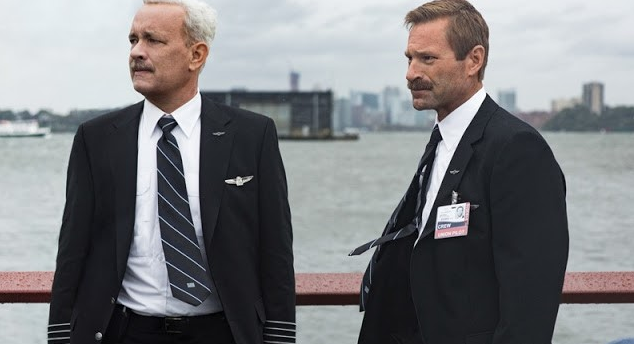News concerning airplanes in New York City is rarely positive, as one character knowingly recalls in Sully. Yet, this film, starring Tom Hanks, uses recent history to make flying exciting again. And although you might not want to be a passenger on this particular plane, the film is an uplifting thrill ride. Sully tells the story of Captain Chesley “Sully” Sullenberger, who famously landed a passenger airliner in the Hudson River in 2009 after an unprecedented engine failure emergency. Hanks delivers a thoughtful performance that glues moviegoers to director Clint Eastwood’s suspenseful blockbuster.
US Airways Flight 1549 struck a flock of birds soon after takeoff, causing the engines to lose power. Unable to return to any nearby airport, Sully (Hanks) saw the icy Hudson as the safest place to crash—or to execute a forced water landing. But, having successfully completed the water landing, the captain’s troubles do not end once his passengers are safely evacuated. Along with First Officer Jeff Skiles (Aaron Eckhart), Sully must endure several days of rigorous review and self-doubt as his reputation is smeared and National Transportation Safety Board investigators accuse him of endangering his passengers’ lives.
Sully is defined by its nonlinear approach to storytelling. Scriptwriter Todd Komarnicki takes advantage of the short duration of the incident to play it again and again, showing it numerous times from varying viewpoints. Some perspectives are imagined: Sully replays the sequence in his head, haunted by the possibility that he could have crashed his passengers into densely-populated Manhattan. Other perspectives are virtual: during an NTSB hearing, the assembled crowd watches as pilots complete four simulations of the flight. Komarnicki does not show the 208-second Flight 1549 incident in full until late in the movie, when NTSB investigators play the cockpit recording at their final hearing.
The back and forth narrative creates a sense of anticipation without ever feeling dragged out. Viewers are constantly faced with the ambiguity of the question: did Sully make the right call? There is a lot of exposition in this film, as the NTSB investigation gradually uncovers new information, but the film captivates the audience’s attention to such a degree that, by the end, the audience wants answers as badly as the government does.
Throughout the movie, the writers whet the audience’s appetite for every detail of the flight as they are revealed piecemeal. When the time finally arrives for the full crash sequence, Sully meets the mark. Masterful direction places the viewer in seemingly myriad perspectives as the plane go down, adeptly edited into a grand, cohesive sequence. Excruciatingly, Flight 1549 seems to fall almost as if in slow motion, watched by New York City from office buildings, from cars driving by, from a helicopter, and finally from the passenger ferry that eventually aids in evacuating the flight’s passengers. The varied perspectives, with Manhattan as the backdrop, build up the plane’s descent to the epic proportions the story warrants.
Contrary to the panoramic shots of the plane, almost all shots of the characters are relatively close up. These close shots combine with quick cuts to keep the tempo fast, but more importantly they facilitate the audience’s connection with Sully. Hanks’ performance elevates the writing and adds depth to the character. He is reserved, but effective, conveying Sully’s concerns and feelings through facial expressions and body language. The viewer sympathizes with Sully from the very beginning until the end—from his distaste for the NTSB investigators to his gratification when it is revealed that he made the right choice.
As a character, Sully is mostly well-developed. The script goes to great lengths to humanize him, demonstrating his dedication as a pilot. His main concern is always his passengers, and Hanks captures that. Sully is humble, more worried about having failed the people who trusted him than about solidifying his reputation as a hero. And he is a team player, praising the numerous other people that helped save the passengers. Eckhart quietly shines in his role as Skiles, with a humorous performance as Sully’s right hand man. But as a father and husband, Sully is a bit flat. His wife occasionally calls him, worried about him and about their money troubles, but there is no emphasis on his home life. In the larger scope of the movie, this shortcoming is not a significant blemish, overshadowed by Sully’s credibility as a pilot.
Sully is absolutely riveting—the fast-paced script makes even the bureaucratic scenes compelling. Eastwood’s direction showcases stunning shots of Flight 1549, and skillfully captures Hanks’ impressive performance: the entire movie hinges on Tom Hanks’ Sully. As the audience shares his uncertainty about his decision and his legacy, Hanks commands our commiseration for his character in a way that only such a talented and veteran actor can.





